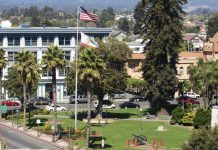WATSONVILLE — On Tuesday, Rolling Hills Middle School students will kick off the planting effort at Hazelwood Park, an open space pocket park adjacent to the school in the City of Watsonville.
Students will be working with Watsonville Wetlands Watch to install native plants throughout the open space in areas designed to improve water quality as runoff drains from surrounding areas into the nearby Struve Slough and along the newly-paved trail corridor, improving the natural habitats and landscaping of the park.
Work on this project began in September. It included the repaving and improvements to a trail that bisects the park, which is used by the local neighborhood and students traveling to and from school. Following the recent completion of the trail paving, local students and volunteers will be aiding Watsonville Wetlands Watch and the City of Watsonville with the habitat planting efforts.
In addition to Tuesday’s work day, volunteers are needed on Saturday, Nov. 17 from 10 a.m. to noon to help with planting native plants and 10 trees throughout the park.
Work on this project is funded by grant funding to the City of Watsonville and Watsonville Wetlands Watch provided by the California Department of Natural Resources Urban Greening Grant Program and the California Department of Fire and Forestry’s Climate Investment Program.
“We’re excited to be entering into the next phase of this project,” said Jonathan Pilch, executive director of Watsonville Wetlands Watch. “Having students planting is a great educational opportunity in terms of teaching them their own ability to make a positive impact in their neighborhood and the surrounding wetlands. We’re hoping to have a great turnout for Saturday’s volunteer day and we feel that this project is a great next step in making measurable progress for environmental health in Watsonville.”
The Hazelwood Park and Rolling Hills Connector Trail improvement project is a part of a city-wide effort to implement urban greening, bicycle and pedestrian trails improvements, and urban forest enhancement projects, identified in the city’s Urban Greening Plan, adopted by the city council in 2012.













